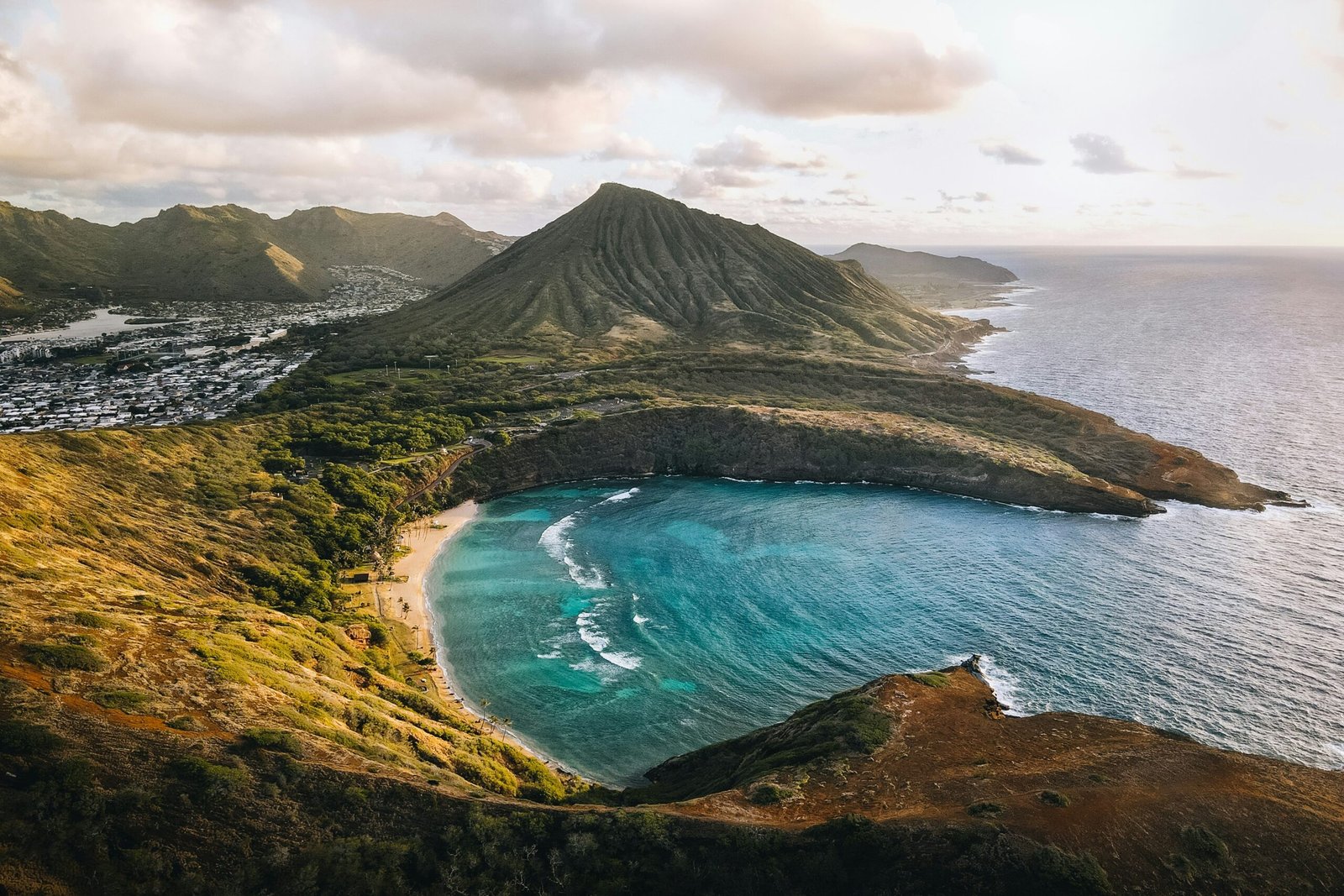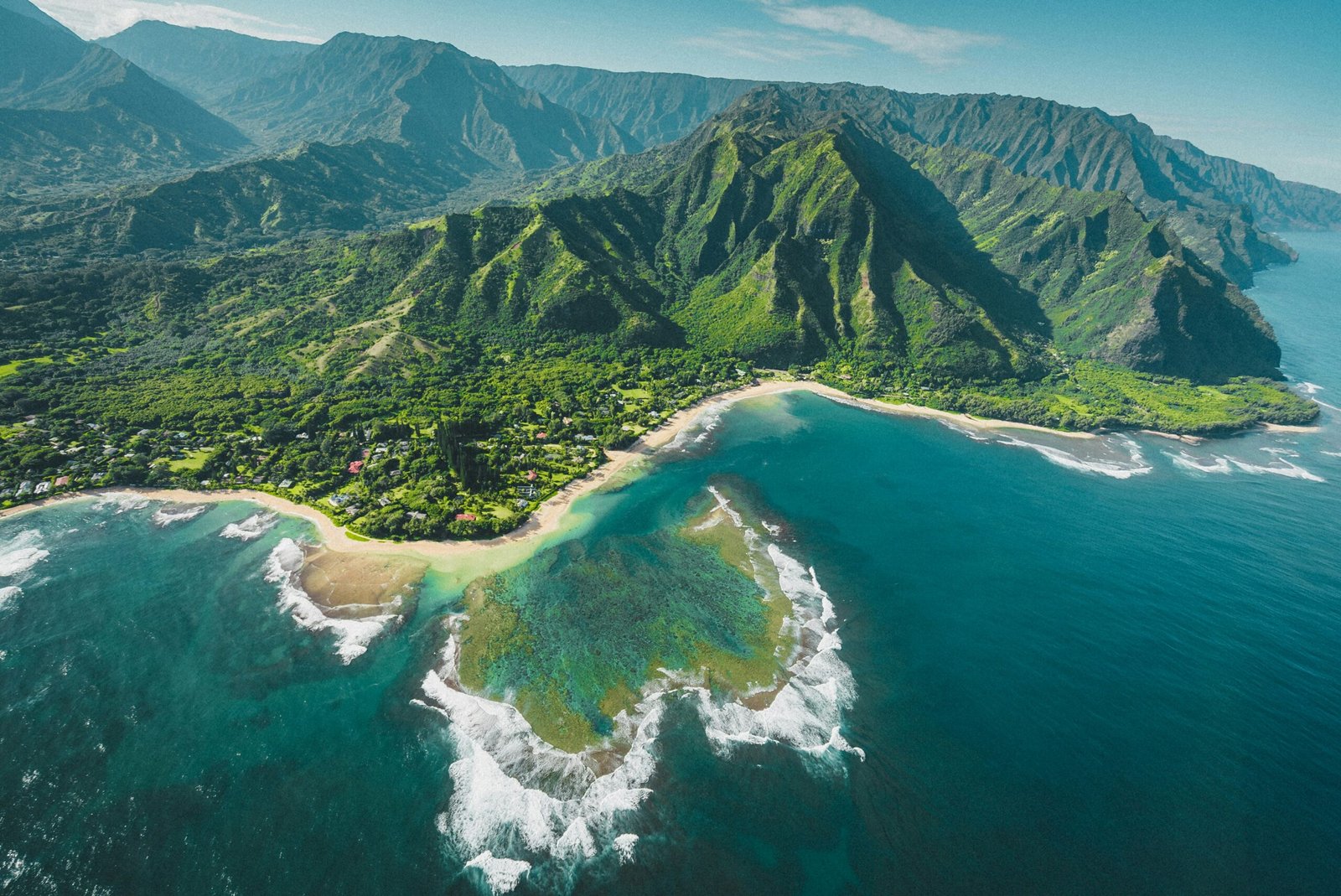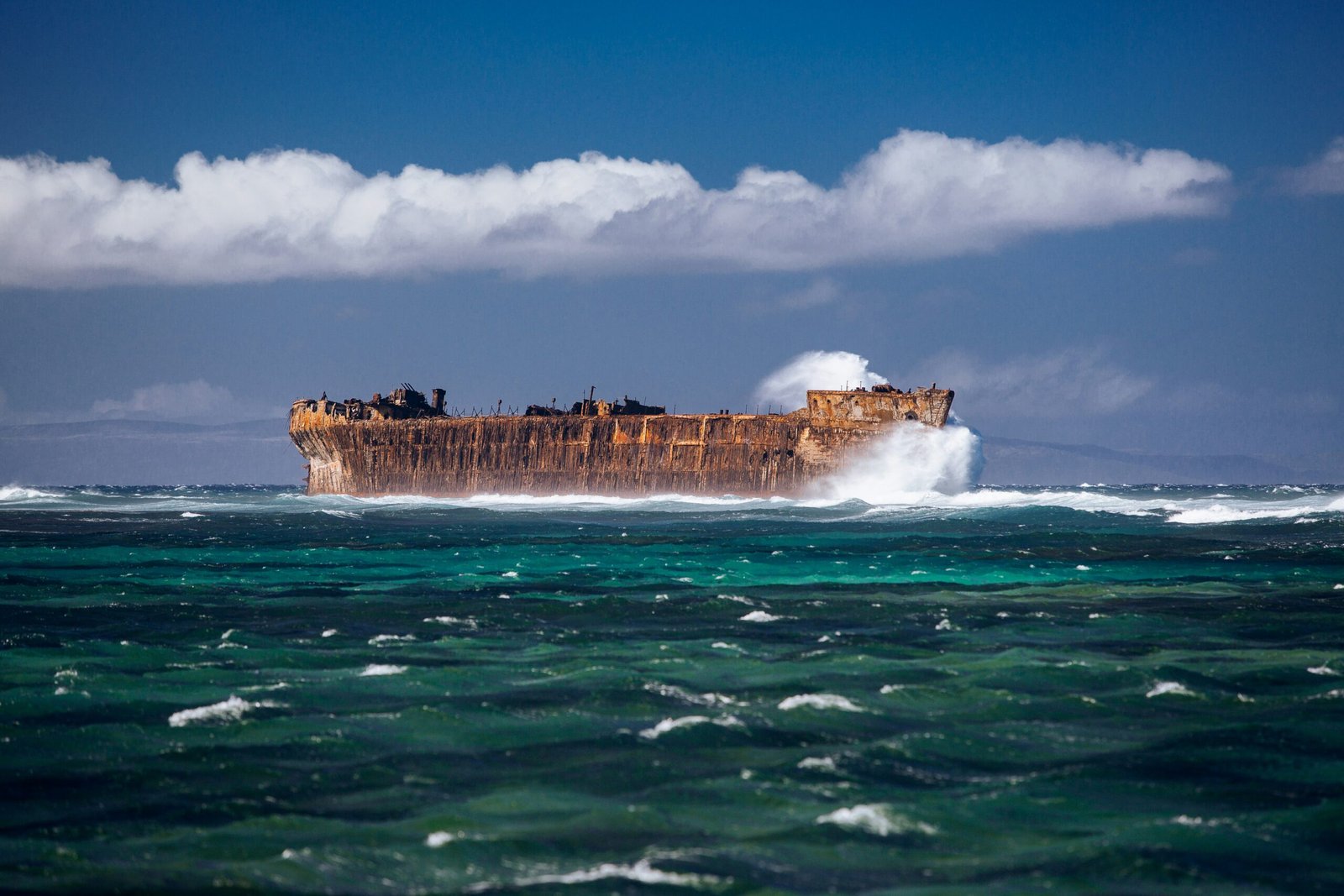Hawaii Basics – Your Guide to the Beautiful Islands
Hawaii, a captivating archipelago comprised of over nineteen volcanic islands, is situated in the heart of the Central Pacific. Its unique geographic location is a result of being positioned atop a geological hot spot. As the Pacific plate steadily shifts to the northwest, the islands gradually grow older and comparatively smaller in size due to natural erosion. Among the collection of islands, eight major ones stand out, with six of them warmly welcoming tourists to explore their beauty and splendor.

From Volcanoes to Green Sand Beaches: Discover the Best of Hawaii’s Big Island
Hawaii, also referred to as the Big Island to prevent confusion, is the largest among the islands. It is home to notable features such as Mauna Kea, Mauna Loa (a highly active volcano and the largest on Earth), Hawaii Volcanoes National Park, as well as coffee and macadamia nut plantations, working ranches, and even green sand beaches. On the dry and leeward side, the busiest area is Kailua-Kona, which is in close proximity to the Kohala Coast mega-resort area that experiences minimal annual precipitation. The saddle road, which is easily accessible and highly recommended despite rental car companies’ warnings, passes between the massive volcanoes and connects Kohala to Hilo. Hilo, the largest town on the windward side, receives over 300 inches of annual precipitation. Hawaii’s distinctiveness is unparalleled and definitely deserves exploration.
Exploring Oahu: The Gathering Place of Hawaii
Oahu (Oʻahu), known as “the Gathering Place,” is a vibrant and bustling island that offers a diverse range of experiences for visitors. As the most populous and developed island in Hawaii, it serves as the governmental and commercial center of the state. With its stunning landscapes, vibrant cities, and iconic attractions, Oahu is a must-visit destination for travelers.

Photo by Peter Thomas on Unsplash
Discovering Honolulu: The Heart of Oahu
Situated on the southern shore of Oahu, Honolulu is not only the state capital but also the largest city in Hawaii. It serves as the cultural, economic, and political hub of the island. With its modern skyline, bustling streets, and vibrant neighborhoods, Honolulu offers a unique blend of urban charm and natural beauty.
One of the most famous tourist destinations in Hawaii is Waikiki Beach, located in the heart of Honolulu. This iconic beach is known for its golden sands, crystal-clear waters, and breathtaking sunsets. Visitors can indulge in a variety of water activities, relax on the beach, or explore the vibrant shops, restaurants, and nightlife that line the shores of Waikiki.
Exploring Beyond the City
While Honolulu is a bustling metropolis, Oahu also offers a serene escape into nature. Just outside the city, you’ll find vast pineapple fields that showcase the island’s agricultural heritage. Take a tour and learn about the history of pineapple farming in Hawaii while enjoying the sweet aroma of fresh pineapples.
For adventure seekers and surf enthusiasts, the North Shore of Oahu is a must-visit destination. Known for its massive waves, the North Shore attracts surfers from around the world, especially during the winter months when the waves reach their peak. Watch professional surfers ride the towering waves or try your hand at surfing under the guidance of experienced instructors.
Paying Tribute at Pearl Harbor
A visit to Oahu would not be complete without a trip to Pearl Harbor, home to the USS Arizona National Memorial. This historic site commemorates the lives lost during the attack on Pearl Harbor in 1941. Visitors can take a boat ride to the memorial and pay their respects to the fallen soldiers. Explore the museum and exhibits to gain a deeper understanding of this significant event in history.
Aside from the USS Arizona Memorial, Pearl Harbor also offers other attractions, including the Battleship Missouri Memorial and the Pacific Aviation Museum. Immerse yourself in the history of World War II and learn about the pivotal role that Pearl Harbor played in shaping the course of the war.
Exploring the Natural Wonders of Kauai’s Garden Isle
Kauai, also known as Kauaʻi, is a breathtaking destination that is often referred to as the “Garden Isle.” This stunning Hawaiian island is renowned for its abundance of natural wonders that are sure to leave visitors in awe.

Photo by Karsten Winegeart on Unsplash
One of the most enchanting features of Kauai is the Wailua River. This majestic river winds its way through lush rainforests and offers visitors the opportunity to embark on a variety of adventures. From kayaking and paddleboarding to taking a scenic boat tour, there are endless ways to explore the beauty of the Wailua River.
Another must-see attraction on Kauai is the awe-inspiring Waimea Canyon. Known as the “Grand Canyon of the Pacific,” this geological wonder spans over 10 miles and boasts vibrant red and orange hues that are truly mesmerizing. Whether you choose to hike along the canyon’s rim or take in the view from one of the lookout points, the beauty of Waimea Canyon is sure to leave a lasting impression.
If you’re seeking adventure and breathtaking views, the Na Pali Coast is a must-visit destination on Kauai. This rugged coastline is famous for its towering cliffs, pristine beaches, and vibrant marine life. Hiking the Kalalau Trail or taking a boat tour along the coast are popular ways to experience the awe-inspiring beauty of the Na Pali Coast.
Lastly, no discussion of Kauai’s natural wonders would be complete without mentioning Mount Waialeale. Known as one of the rainiest spots on Earth, this mountain is a haven for lush vegetation and cascading waterfalls. While reaching the summit of Mount Waialeale is a challenging feat, the views and the sense of accomplishment are truly rewarding.
Whether you’re a nature enthusiast or simply seeking a peaceful retreat, Kauai’s Garden Isle offers a wealth of natural wonders to explore. From the majestic Wailua River to the breathtaking Waimea Canyon and the awe-inspiring Na Pali Coast, Kauai is a paradise for outdoor adventurers and nature lovers alike.
Exploring Molokai: The Friendly Isle
Molokai, also known as Molokaʻi, is a hidden gem among the Hawaiian Islands. With its untouched beauty and laid-back atmosphere, it is often referred to as the “Friendly Isle.” Unlike its more developed counterparts, Molokai offers a unique experience that is perfect for those seeking a peaceful and authentic Hawaiian getaway.

Photo by Jake Houglum on Unsplash
One of the island’s notable landmarks is Kalaupapa, located on Molokai’s north shore. This historic site was once a leper colony and is closely associated with the renowned Father Damien. Visitors can explore the area and learn about the inspiring stories of those who lived there. It is a place of both historical significance and natural beauty.
Aside from its historical landmarks, Molokai boasts stunning natural landscapes that are worth exploring. The island is home to lush valleys, dramatic sea cliffs, and pristine beaches. Outdoor enthusiasts can embark on hikes through the Halawa Valley, where they can discover hidden waterfalls and immerse themselves in the island’s natural splendor.
Molokai’s small towns and villages offer a glimpse into the local way of life. Kaunakakai, the island’s main town, is a charming hub with local shops, restaurants, and a weekly farmers market. It is the perfect place to experience the island’s warm hospitality and sample delicious Hawaiian cuisine.
For those seeking a truly authentic Hawaiian experience, Molokai is the ideal destination. Its untouched beauty, rich history, and friendly locals make it a paradise waiting to be discovered. Whether you’re exploring the historic Kalaupapa or simply relaxing on one of its secluded beaches, Molokai is sure to leave a lasting impression.
The Transformation of Lanai: From Pineapple Plantation to Exclusive Resorts
Lanai, also known as Lānaʻi, holds a fascinating history that showcases its journey from being the largest pineapple plantation in the world to becoming a haven for exclusive resorts. Once completely owned by Dole Foods, this picturesque island has undergone a remarkable transformation.

Photo by Anton Repponen on Unsplash
In the past, Lanai was renowned for its vast pineapple plantations, with Dole Foods dominating the industry. The island’s fertile soil and favorable climate made it the perfect location for pineapple cultivation. At its peak, Lanai supplied pineapples to the entire world, earning it the title of the largest pineapple plantation on the planet.
However, as the pineapple industry faced challenges and changes in demand, Lanai’s future took a different turn. In 2012, the majority ownership of the island was acquired by Larry Ellison, the co-founder of Oracle Corporation. Under Ellison’s ownership, Lanai underwent a significant transformation.
Today, Lanai is a destination known for its exclusive resorts that offer unparalleled luxury and tranquility. The island’s natural beauty, pristine beaches, and lush landscapes make it a sought-after retreat for travelers seeking a secluded paradise. Visitors can indulge in world-class amenities, exquisite dining options, and a range of outdoor activities.
Despite the transformation, remnants of Lanai’s pineapple plantation heritage can still be found. The island’s rich history is celebrated through various cultural attractions and events, providing visitors with a glimpse into its agricultural past.
Lanai’s journey from a pineapple plantation to a haven for exclusive resorts is a testament to the island’s adaptability and the vision of its owners. Today, it stands as a testament to the island’s ability to reinvent itself while still honoring its heritage.
Exploring Niihau: Hawaii’s Privately Owned Island
Niihau, also known as Niʻihau, is a unique and privately owned island located in Hawaii. What sets Niihau apart from other Hawaiian islands is its exclusive access and entirely Native Hawaiian population. For many years, the island was off-limits to the general public, with only family members and invited guests of the owners allowed to visit.

Photo by Studio Kealaula on Unsplash
Recently, however, limited tourism opportunities have become available for those who wish to explore this hidden gem. Tourists can now experience the beauty of Niihau through helicopter rides, ATV tours, and hunting excursions that originate from the neighboring island of Kauai.
One of the main attractions of Niihau is its pristine natural beauty. With its secluded beaches, crystal-clear waters, and untouched landscapes, the island offers a glimpse into Hawaii’s unspoiled past. Visitors can immerse themselves in the tranquility of the island, away from the hustle and bustle of more touristy destinations.
Another highlight of Niihau is its rich Native Hawaiian culture. The island is home to a community that has preserved its traditions and way of life for generations. Visitors have the opportunity to learn about the customs, language, and arts of the Native Hawaiian people, gaining a deeper understanding of the island’s history and heritage.
While tourism to Niihau is still limited, the chance to visit this privately owned island is a rare and special experience. It allows visitors to connect with Hawaii’s natural beauty and immerse themselves in its unique cultural heritage. So, if you’re looking for an off-the-beaten-path adventure in Hawaii, consider exploring Niihau and discovering a side of the islands that few have had the privilege to see.
The Rehabilitation Efforts of Kahoolawe: Restoring an Uninhabited Island
Kahoolawe, or Kahoʻolawe as it is known in Hawaiian, is an island that holds a unique history. Once used as a U.S. Navy bombing range, it remains uninhabited today. However, efforts are underway to rehabilitate the island and restore its natural beauty.
The island of Kahoolawe, located in the Hawaiian archipelago, has suffered from years of military use. The U.S. Navy used the island for target practice and bombing exercises from World War II until the 1990s. As a result, the island’s ecosystem was severely damaged, and its cultural significance to the Hawaiian people was diminished.
Recognizing the need for restoration, the Kahoolawe Island Reserve Commission was established in 1993. This commission, composed of representatives from various Hawaiian organizations, works to protect and restore the island. Cleanup efforts have been ongoing, with the removal of unexploded ordnance and the restoration of native vegetation.
The rehabilitation of Kahoolawe goes beyond environmental restoration. It also involves reconnecting the island to its cultural heritage. The commission works closely with the Hawaiian community to ensure that traditional practices and knowledge are incorporated into the island’s management. This includes the revitalization of traditional fishing practices and the preservation of sacred sites.
While progress has been made, the rehabilitation of Kahoolawe is a long-term endeavor. The island still bears the scars of its past, and complete restoration will take time. However, the commitment and dedication of the Kahoolawe Island Reserve Commission and the Hawaiian community give hope for a brighter future for this once-neglected island.


